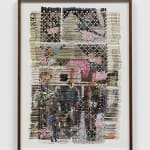


Miguel Arzabe
Los Angeles #1, 2021
woven archival ink on archival paper
Artwork: 36 x 24.5 in
Framed: 40 x 28.5 in
Framed: 40 x 28.5 in
Further images
Miguel Arzabe sources paper ephemera and promotional materials from art exhibitions in specific locales, such as Los Angeles, San Francisco, New York, and Paris, to create intricate weavings with elaborate...
Miguel Arzabe sources paper ephemera and promotional materials from art exhibitions in specific locales, such as Los Angeles, San Francisco, New York, and Paris, to create intricate weavings with elaborate geometric designs. Tejido Cultural (which, when translated to English from Spanish, means cultural fabric) speaks to the ways in which Arzabe’s mestizx identity informs and inspires both his technical process and the materials he enlists. Born and raised in the United States by parents who immigrated from Bolivia, his practice draws from a longstanding and evolving tradition associated with indigenous peoples of Bolivia and the greater Andes region.
Rather than using traditional materials such as alpaca wool or the now more commonly used synthetic yarns, the artist collects and archives ephemera from galleries and museums that reflect a Western art canon. By combining indigenous techniques and references together with the material ephemera of American and European contemporary art, Arzabe materializes the cultural production of a city into a geometric matrix, fusing his heritage with the contemporary culture of his present moment.
Rather than using traditional materials such as alpaca wool or the now more commonly used synthetic yarns, the artist collects and archives ephemera from galleries and museums that reflect a Western art canon. By combining indigenous techniques and references together with the material ephemera of American and European contemporary art, Arzabe materializes the cultural production of a city into a geometric matrix, fusing his heritage with the contemporary culture of his present moment.
8
of
8


